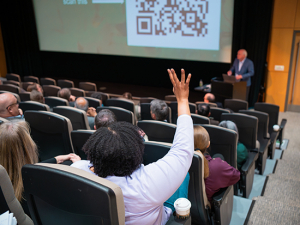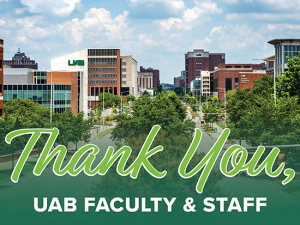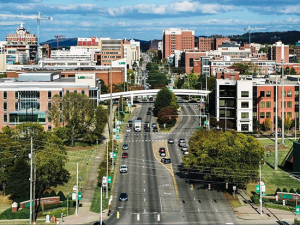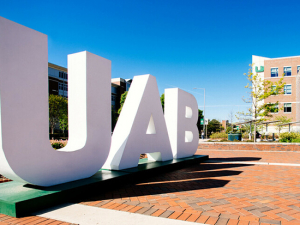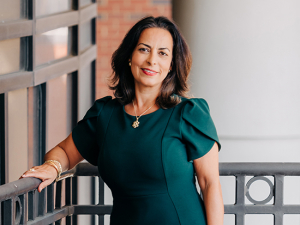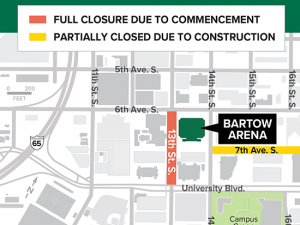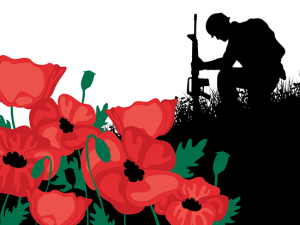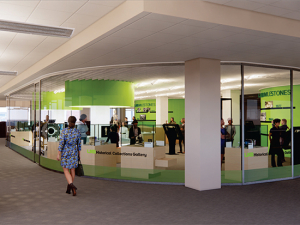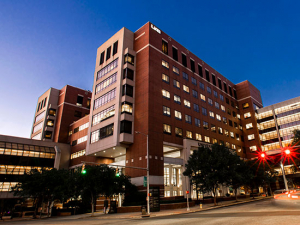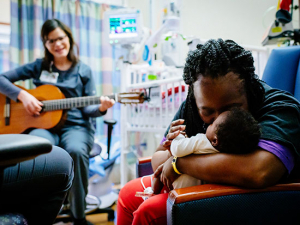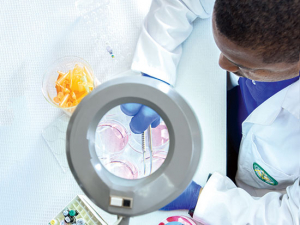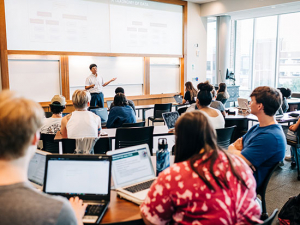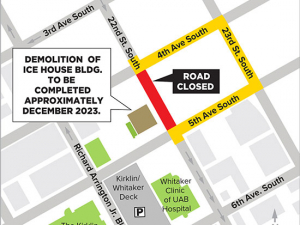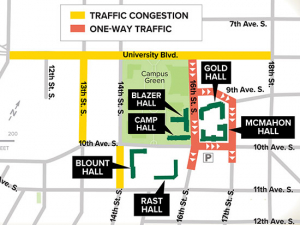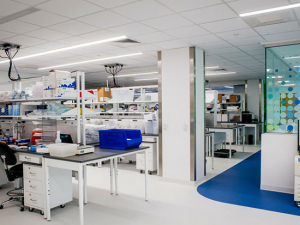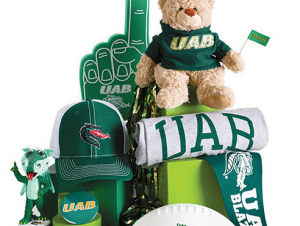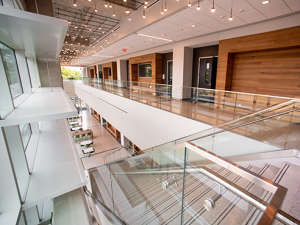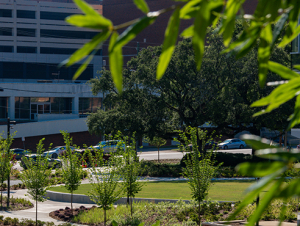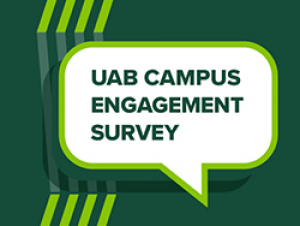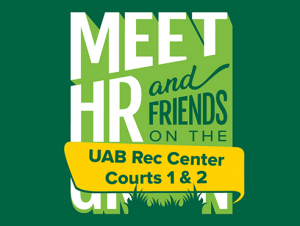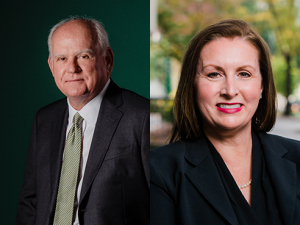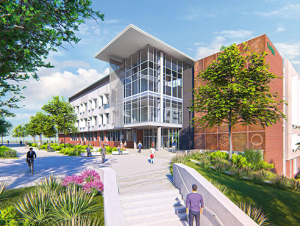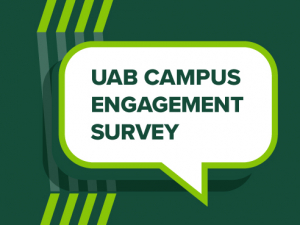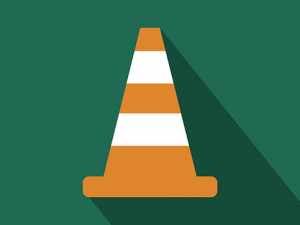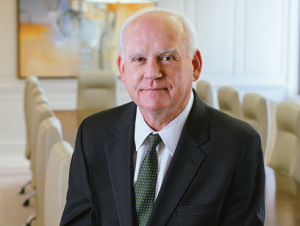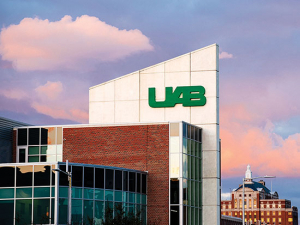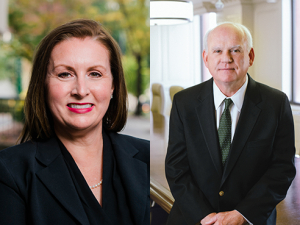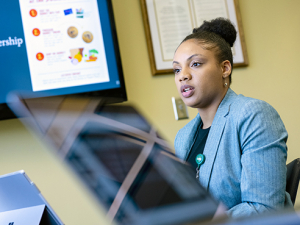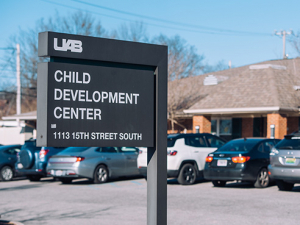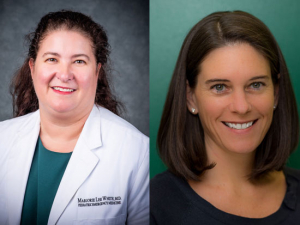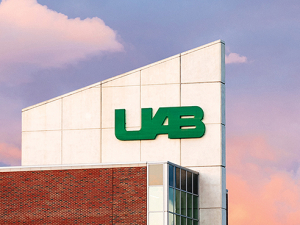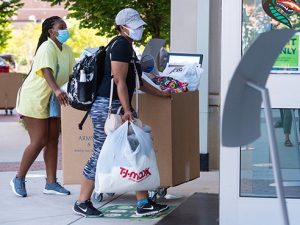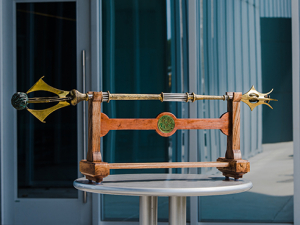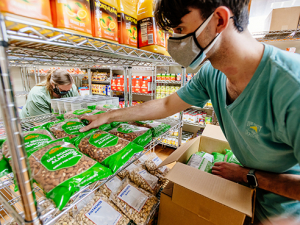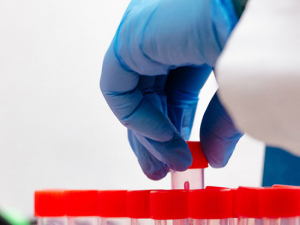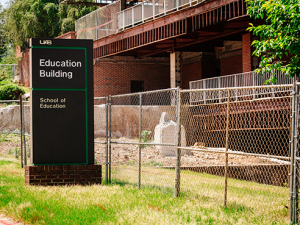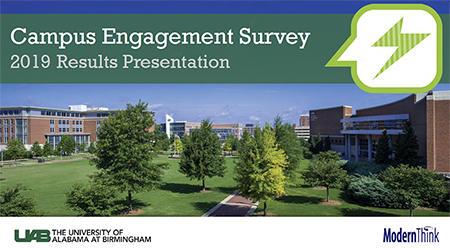
Employees can download a copy of the PowerPoint presentation or view a video of the live presentation on the Campus Engagement website, uab.edu/engage.The results are in for the campus engagement survey UAB conducted earlier this year to assess its strengths and weaknesses and identify tools, resources and programs needed to promote and sustain individual and institutional growth.
“Great messages came through,” President Ray Watts said during the results presentation April 18. “One is that our employees are proud to work at UAB and proud to pursue the mission.”
Also topping the list of UAB’s strengths as an institution are job satisfaction, employee relationships with immediate supervisors, professional development, work/life balance, benefits, diversity and inclusion.
The results “are encouraging and also give insight on how we can continue to improve,” Watts said before introducing Rich Boyer of ModernThink, UAB’s survey partner, who detailed the results of the survey for those attending.
Nearly 5,000 faculty and staff shared their thoughts on their workplace experiences and key themes emerged in response to the 65 statements with which they were asked to agree or disagree. The survey was benchmarked against the 2017 ModernThink survey so UAB could measure progress in the areas targeted for improvement due to those results: communication, performance management and leadership.
ModernThink analyzed the quantitative and qualitative data and identified the university’s strengths, the areas most improved, the 10 most positive statements and those in the bottom 10. These were presented in two public forums; employees can download a copy of the PowerPoint presentation or view an enhanced video of the presentation on the Campus Engagement website, uab.edu/engage.
“I’ll encourage you to take a breath and celebrate the good work you’ve done,” Boyer said. “I’ll also encourage you to roll up your sleeves and keep going. But you’ve made some really good progress in relatively short order, so I hope you’ll celebrate that as the important and significant milestone it is.”
What did the survey tell us?
Specific answers to questions demonstrated UAB strengths and also identified areas that need more work. Equally important, it provided evidence of progress, confidence and increasing satisfaction, Boyer said.
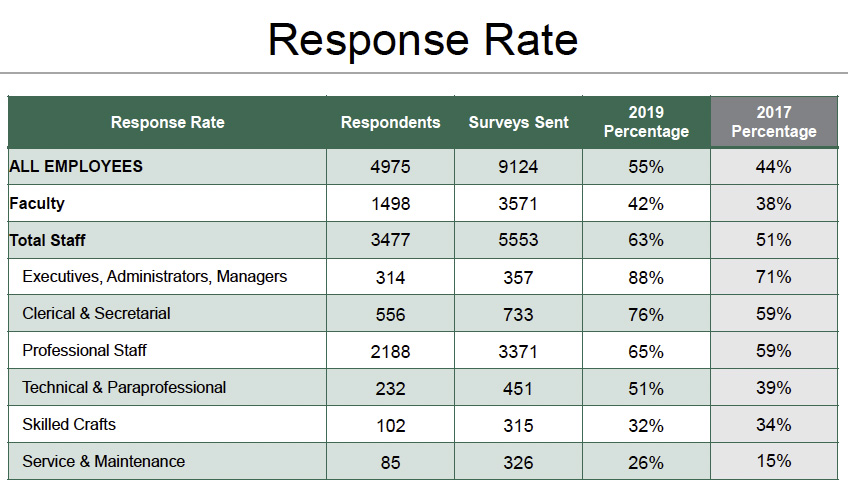 1. More employees had their say. The number of employees surveyed increased to 9,124 from 6,394 in 2017, and still the overall response rate increased 11 points — to 55 percent. Among faculty, the response rate increased 4 points to 42 percent, and rates for combined staff categories increased 12 points to 63 percent.
1. More employees had their say. The number of employees surveyed increased to 9,124 from 6,394 in 2017, and still the overall response rate increased 11 points — to 55 percent. Among faculty, the response rate increased 4 points to 42 percent, and rates for combined staff categories increased 12 points to 63 percent.
Typical concerns employees have about completing institutional surveys are whether or not their responses will be confidential and anonymous and whether or not any action will be taken based on the results, Boyer said. The increase in participation indicates employees had “less concern about anonymity and more confidence that it would actually result in something,” Boyer said. “You would not have achieved a 55% response rate if people did not have a greater sense of confidence in the process itself.”
2. More employees were pleased in all areas.
UAB posted “consistent and notable improvement” in each of the 15 dimensions category assessed — from the highest for institutional pride (81 percent) to communication (58 percent). Overall, the positive average for responses to all survey statements increased 5 points to 69 percent for 2019; the overall negative dropped 3 points to 10% from 13%.
“Combined, we have an 8-point swing,” Boyer said. “In a two-year survey cycle, particularly given that was your first deployment in 2017, that is nothing short of excellent progress.
“A swing of 5 or more points is not an accident of chance, really not a spurious statistical result,” Boyer said. “Something is going on where we see movement of 5 points or more.”
In addition, responses to 15 statements improved 10 or more percentage points. “When you see swings of 10 points or more, that is dramatic. That is significant. It is unusual that we see those kind of improvements — particularly in a short cycle,” Boyer said.
Boyer said the improved results reflect the initiatives UAB has undertaken in target areas: “When you all choose to focus on something, you actually make some progress.”
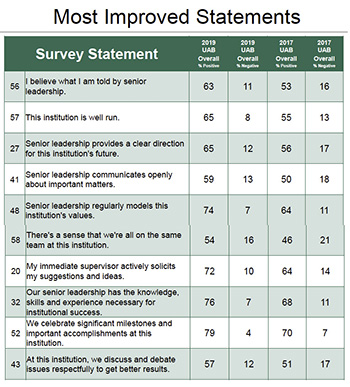 Click to enlarge
Click to enlarge
3. More employees viewed senior leadership favorably.
ModernThink provided a list of Most Improved Statements based on a comparison of survey results from 2017 and 2019. Six of the 10 reflected increased trust and confidence in the leadership of UAB’s president, provost, deans and vice presidents. The remaining four primarily focused on shared values across the institution.
Boyer noted that “one of the things that emerged in the survey results in 2017 was the faculty and staff both were eager for a greater sense of clarity in terms of where we were going as a community and as a university. What’s our strategic direction? How are we going to get there?”
The work that has been done to launch Forging the Future, UAB’s strategic plan, and articulate the shared values for the university is being recognized, he said. “The rollout of the strategic plan was timely, and frankly, one of the statements where we see some of the most significant improvement from 2017, is the statement related to senior leadership providing a clear direction for this institution’s future.”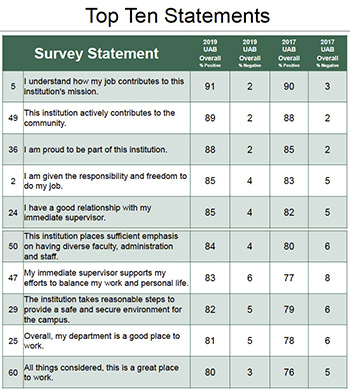 Click to enlarge 4. More people say ‘it's a great place to work’
Click to enlarge 4. More people say ‘it's a great place to work’
Nine of the Top 10 statements most people agreed were true in 2017 returned to this year’s list — and improved while doing it — which Boyer says illustrates “the sense of mission, sense of pride and collegiality and camaraderie” at UAB.
Coming in as the new No. 10 with an 80% overall positive rating: “All things considered this is a great place to work.”
Numbers nine (Overall, my department is a good place to work) and 10 are what Boyer called barometer statements that give “an important sense of the overall experience.” The congruency between the two, he said, “is a nice finding.”
But a quality of great workplaces is they don’t take their strengths for granted, Boyer said. “We understand what our strengths are. We build on them. We make them more consistent and stronger for more people.”
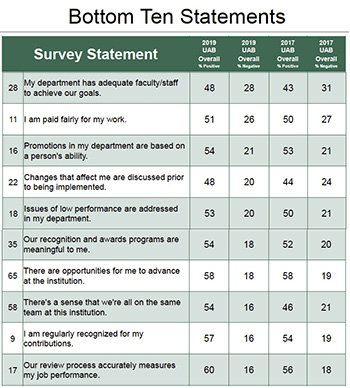 Click to enlarge5. More room for improvement
Click to enlarge5. More room for improvement
The bad news is that the work is never done. There will always be a Bottom 10 so there will always be targets for improvement. Boyer suggested issues related to resource constraints, performance management and communication are likely to be among them across any industry.
As was done with the 2017 results, leadership will develop a plan to address the deficiencies and share those with the UAB community.
The good news is that the overall positive ratings for items in the Bottom 10 rose to a low of 48% positive to a high of 60% positive; in 2017 the overall range was 43%-52%. Four statements that moved up and out of the basement were statements about leadership and communication.
Boyer noted this is progress, but the bottom ratings are “still at a level where concerted effort is needed.”
What happens now?
ModernThink offered the following recommendations based on its analysis:
- Continue to connect employees to the vision, mission, values and strategic plan
- Continue identifying and developing managerial/ leader competencies across UAB
- Build on efforts to create greater alignment across levels of leadership
- Continue to strengthen performance management processes, tied to values
- Identify critical conversations/ topic areas in which organizational leaders should be fluent and consistently address.
The next steps are to develop action plans, identify tools, resources and programs needed to improve in these areas and report on efforts and progress to the UAB community.
Similarly, vice presidents and deans will be sharing school and unit-level results with their respective teams and developing plans to pursue improvements that are specific to their employees within this timeline:
- Cascade results throughout the unit by Sept. 1 through written communications and face-to-face meetings
- Identify two to three actionable goals by Jan. 1, 2020, and submit to Watts or Provost Pam Benoit.
- Begin to put those plans into place upon approval.
Employees are encouraged to participate and provide essential feedback.
“We want everyone here to bring their best ideas forward to help us all work together for the greater good and to do great things for our people, our community, our state, our nation and for people around the world. Because the work we do has global impact,” Watts said.